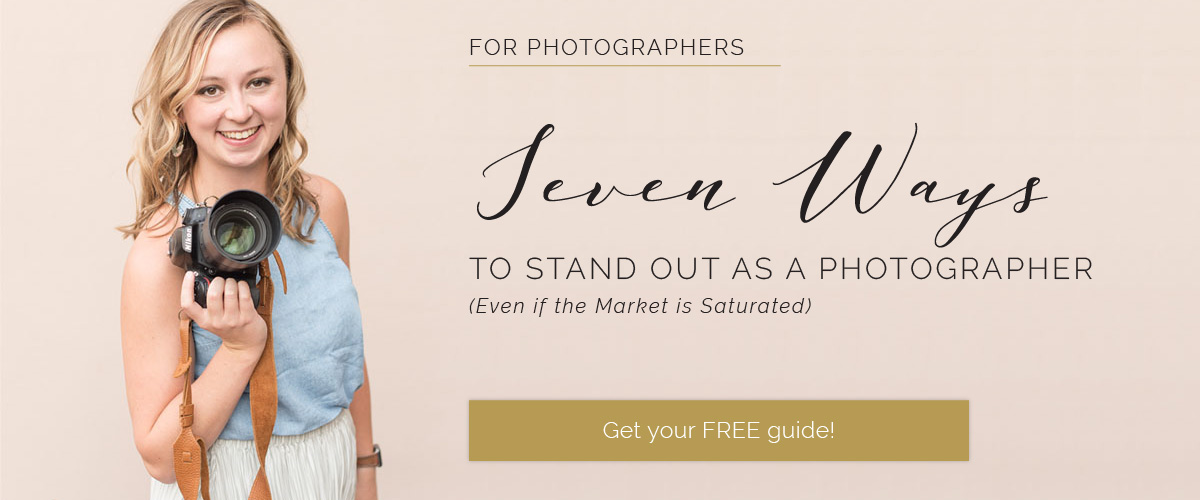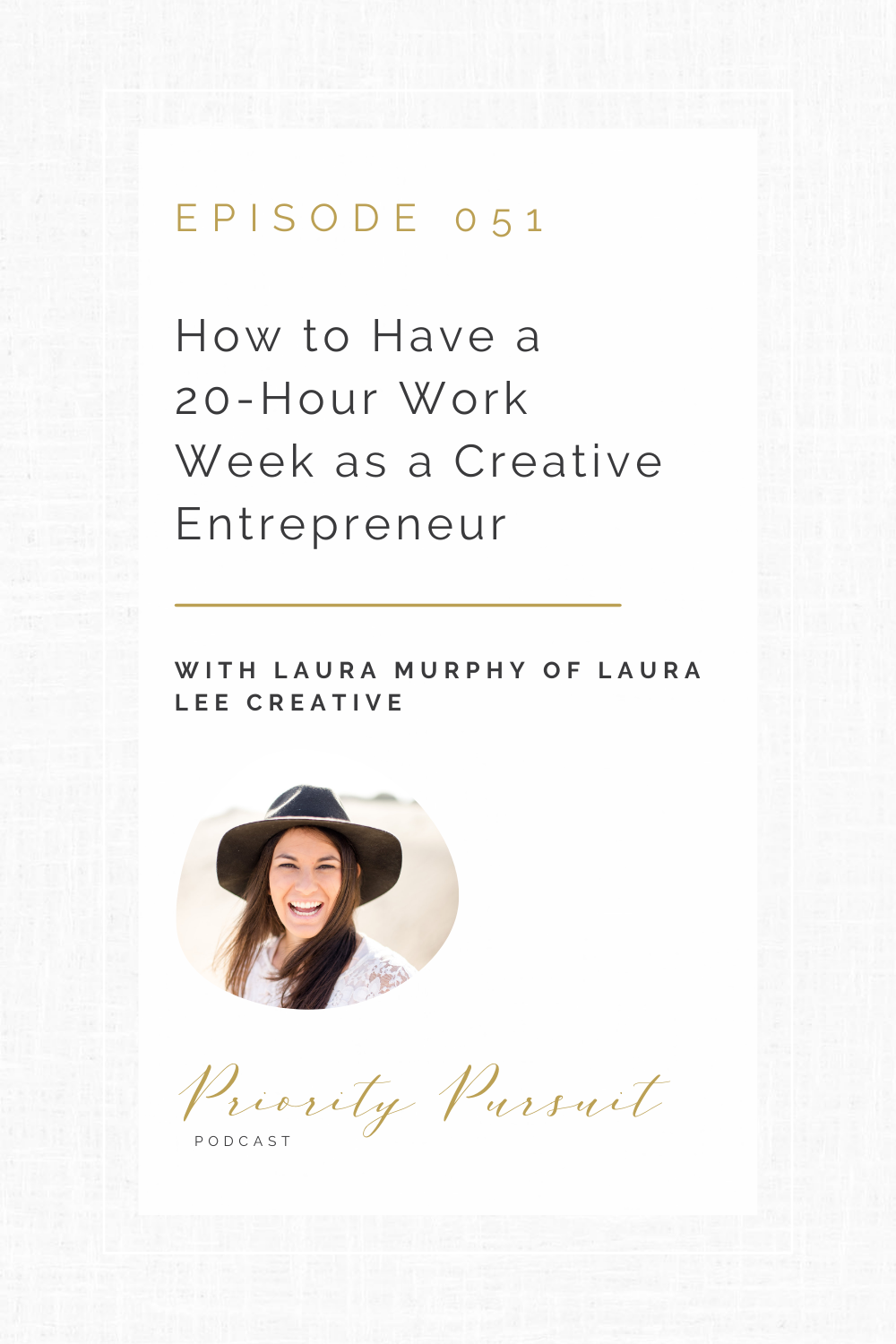Let's Connect!
Check Out Wedding Photography Packages]
I understand how much your wedding photos mean to you and how much work you’re putting into planning every last detail of your big day. As a VRP bride, you can relax and enjoy your wedding day knowing you’ve chosen a team of photographers who are just as detail-oriented as you are, will put thought into every shot, and will pay attention to all of the little details to ensure that you and your spouse love your wedding photos.
And, I’m an Indy wedding photographer for the type-A bride.
I'm Victoria Rayburn
Hey there!
Episode 051: How to Have a 20-Hour Work Week as a Creative Entrepreneur with Laura Murphy of Laura Lee Creative
Spotify | Apple Podcasts | Stitcher
YES, friend. You did read the title of this episode correctly; a “20-hour work week” is not a typo. If you’re trying to find a semblance of work-life balance (which we don’t believe exists perfectly as a reminder), get your time back, and stop burning the candle at both ends, then you don’t want to miss this episode of Priority Pursuit!
Laura Murphy of Laura Lee Creative is a photographer, systems strategist, business coach, and retreat host for creative entrepreneurs, as well as the creator of TAKE BACK YOUR TIME—an online course all about streamlining your business. Laura educates the creative community on all things workflow, systems, productivity, and time management to help creative entrepreneurs live and enjoy their lives while running THRIVING businesses!
Laura knows firsthand what it’s like to be burned out from over working. When she worked a 9-5 job while building her photography business at night and on the weekends, she thought, “Once I go full time, all will be well.” However, even when she shifted to doing photography full time, Laura still had to work around the clock.
Knowing she couldn’t maintain such a schedule, Laura created workflows and systems for her business that protected her time and let her live life outside of work. Today, Laura can operate her photography business in less than 20 hours per week, and she’s teaching other creative entrepreneurs how they can do the same.
In this episode of Priority Pursuit, Laura explains how to create workflows and systems so that when you finish this episode, you’ll know how to have a 20-hour work week as a creative entrepreneur!
First, is a 20-hour work week even possible?
As a creative entrepreneur, you’re likely taking something you love to do and are passionate about and are working hard to grow your passion into a thriving business. But, so often, creatives tend to wind up buried in a 60-plus-hour work week, constantly pressed for time, and grinding towards burnout.
In Laura’s own words, “The sad thing is our passions can so quickly become a burden when they’re not making enough money, when they’re burning us out, and [when they’re] taking up way too much of our time. Because, the thing we’re passionate about is the thing we’re spending the least amount of time on as business owners.”
So, it still begs the question, is a 20-hour work week even possible? The answer is YES. According to Laura, a 20-hour work week becomes possible when you put workflows and systems into place that protect your time, promote your business, and ultimately help you live your life while running a thriving business without working around the clock.
Your time is valuable and whether you’re just getting started as a creative entrepreneur, have been a small business owner for a long time, or are on the brink of burnout, it is never too late to put workflows and systems into place that help you work less and live more.
Let’s break down how to have a 20-hour work week as a creative entrepreneur (that’s actually profitable).
Well, that all sounds great, but how do you have a 20-hour work week as a creative entrepreneur?
Laura shares that the key to being able to work less is to not reinvent the wheel every time there is a task or job you need to do. Your time is valuable and you want to use it effectively. In other words, work smarter not harder. And, in this episode, Laura shares the following four steps you need to take to do just that:
1. Structure
According to Laura, the first thing you need to do is to create structure for your business through workflows. In this episode, Laura defines a workflow as an “A-Z sequential order of all the actions you do from the beginning of a project or service to its completion.”
For example, Laura has a workflow for wedding photography inquiries that includes 16-18 steps and another workflow for when her clients have booked her services for their wedding, which includes 169 steps. These workflows include every single action from the initial email inquiry to the email Laura sends on her clients’ one-year wedding anniversary.
Whew! That is a lot of steps in those workflows, but Laura shares that some of the steps are simple and include things like sending a questionnaire, emailing a brochure, or texting a client saying you can’t wait to see them.
A solid structure is a huge first step toward having a 20-hour work week as a creative entrepreneur. Designing your workflows and listing out every step from A-Z is a lot of work up front, BUT it is well worth it in the long run. With these workflows in place, you’re creating a foundation for your business that is built on protecting your time, working efficiently, and enabling you to better serve your clients.
2. Streamline
Once you’ve outlined all the actions associated with your projects or services, you can then start addressing the actions that can be repeated, which according to Laura are your email templates, invoice templates, contracts, or any other repeatable action (actions or tasks you have to do again and again) in your business.
Once you’ve determined which actions can be repeated in your business, then create templates for each one of those actions. For example, if you create an email template welcoming a new client, that template can be used to welcome every client moving forward. These templates will not only save you time in the long run, but they are also necessary to help you in the next phase where you’ll put systems in place.
3. Systematize
Even with templates, there are still a lot of moving parts in your business, and just the time spent copying and pasting from templates in a Google Doc can add up. This is why Laura emphasizes the importance of having a customer relationship management system (CRM).
*In this episode Laura shares that she uses Honeybook as her CRM. This may be a great choice for your business, but don’t hesitate to research options and choose the CRM that works the best for you. Personally, I use Iris Works.*
In this step, Laura explains that the first thing you need to do is take the templates you created in the “streamline” phase and upload them into your CRM. Next, input your workflows that you created so that each step is listed in order. Then, attach the appropriate templates to each of your workflows. This will result in a digital version of your workflow where reminders will be given, emails can be automatically sent, and every step and aspect will be scheduled to complete a job.
For example, if you have an inquiry workflow, attach the templates you created for inquiry emails and questionnaires to that workflow. And, then repeat this process for any other workflows you put into your CRM.
In addition, with your CRM, you can assign triggers for each of the tasks/actions you need to complete within a given workflow. These serve as automated reminders of what you need to get done when working on a project or providing a service for your clients.
According to Laura, the end goal is that with everything uploaded to your CRM, you’ll have a daily action list. Then, each day, you can check your task manager and work through whatever tasks are needed that day. With all of your templates and workflows uploaded into a CRM, you’ll have a system that supports your business,protects your time, and allows you to serve your clients well.
4. Scale
Once you have a solid workflow in place for yourself, it’s time to make preparations so that a new team member can jump into your business and begin aiding in these workflows by developing your standard operating procedures (SOPs). (Side note: Even if you aren’t planning on hiring anytime soon, don’t skip this step. SOPs will help you streamline your work even if you’re the only person part of productions, and if something were to happen to you, having SOPs will allow others to step into your business and offer assistance.)
Laura defines an SOP as a written or video documentation of how the tasks within your workflows are carried out. In other words, each task should have an explanation of exactly how to do it and any general business policies associated with that task.
For example, Laura shares when a client wanted to add to their team so they could have more time with their family, Laura helped her client create SOPs so that the new hires knew exactly how each process and procedure worked in the business. It took loads of time off of Laura’s client’s plate and allowed her client to spend time with her family and focus on other creative pursuits to grow her business.
When you have SOPs in place, you can take back your time—whether your SOPs help you have a more clear idea of what needs to be accomplished or allow you to hand off tasks to someone else. This will, then, prevent so much of your time from going to maintenance tasks and give you the opportunity to focus on what you’re passionate about in order to keep moving the needle forward in your business.
Want more system & streamlining help from Laura? Register for her online course- TAKE BACK YOUR TIME!
A 20-hour work week is yours for the taking; start putting together your workflows & systems!
So, are you now feeling like you know how to have a 20-hour work week as a creative entrepreneur? Because, Laura is proof that a 20-hour work week is possible! As common as it is for creative entrepreneurs to work 60 plus hours per week and struggle with burnout, this lifestyle does not have to be the norm.
Laura shares that you have a choice to make and that’s whether you’ll “spend your time” or “invest your time.” The fact of the matter is that when you choose to spend your time, you’re not usually getting any return on that time. But, if you invest your time creating workflows, systems, and SOPs, you’re going to earn hours upon hours of your time back.
On top of this, when you create workflows and systems that protect your time, you are able to serve your clients better and grow your business.
Alright, friend. Are you ready to invest your time? If so, start creating workflows and systems that work for your business and are supportive of living life while running a THRIVING business!
Want to hear more from Laura
If you’d like to hear more from Laura, you can find her on Instagram at @lauraleecreative, on Facebook, on Pinterest, and at lauraleecreative.com.
And, if you’d like even more help from Laura setting up workflows and systems, you can become one of her students! Register for her online course TAKE BACK YOUR TIME: The Complete Framework to Creating Workflows and Systems that Maximize Efficiency, Streamline Your Business and Help You Find Balance as a Small Business Owner!
Links & Resources Mentioned in This Episode
Laura Lee Creative’s FREE Quickstart Guide
Laura Lee Creative’s Take Back Your Time Course
The E-Myth Enterprise: How to Turn a Great Idea into a Thriving Business by Michael E. Gerber
Profit First by Mike Michalowicz
Receive 50% Off Your First Order with Photographer’s Edit
Receive $20 Off Your First Pair of Rothy’s
Join the Priority Pursuit Facebook Community
Follow or DM Victoria on Instagram
 Did you enjoy this episode? If so, pin it to save it for later! Follow me on Pinterest for more marketing, business, branding, and boundary-setting strategies!
Did you enjoy this episode? If so, pin it to save it for later! Follow me on Pinterest for more marketing, business, branding, and boundary-setting strategies!

Let's Connect!
Check Out Wedding Photography Packages]
I understand how much your wedding photos mean to you and how much work you’re putting into planning every last detail of your big day. As a VRP bride, you can relax and enjoy your wedding day knowing you’ve chosen a team of photographers who are just as detail-oriented as you are, will put thought into every shot, and will pay attention to all of the little details to ensure that you and your spouse love your wedding photos.
And, I’m an Indy wedding photographer for the type-A bride.
I'm Victoria Rayburn
Hey there!
© 2023 Victoria Rayburn Photography. All rights reserved. | Terms & Conditions | Privacy Policy
Let's Connect!
@victorialrayburn
Let's Connect! | @victorialrayburn
Schedule a Coffee Date
However, as a VRP bride, you can relax and enjoy your celebration while being confident that every moment and detail is being thoughtfully photographed!
